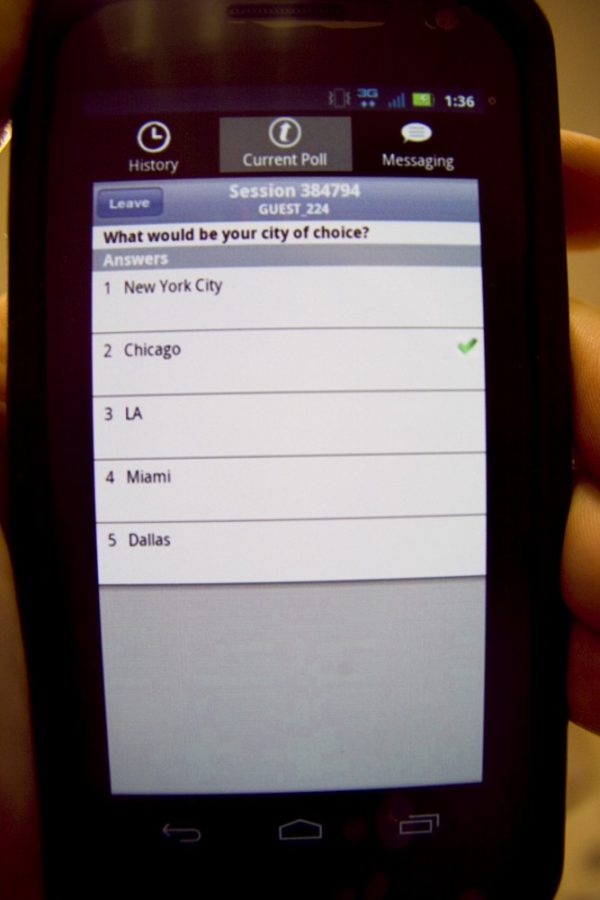Now that the university recently chose one brand of clicker, Turning Technologies, to be used campus-wide, students may not need to worry about buying a clicker device at all, thanks to a new app.
Students can now buy and download the company’s application, ResponseWare, on their smartphone, tablet or laptop instead of buying a clicker at the bookstore, as long as their instructor isn’t opposed to the use of multimedia technology in the classroom. The cost of the application varies based on the length of the license.
While some students and professors see the clicker app as a benefit to the classroom, others strongly oppose the idea, unable to see any benefit of having a multimedia device active during lectures.
“It’s highly dependent on the preferences of the faculty in terms of what they want to see occur in the class,” said Michele Norin, chief information officer and executive director of University Information Technology Services.
Steve Kortenkamp, a visiting instructor in planetary sciences, has allowed one of his students to use the clicker application on his iPad and the student has had to overcome a few problems with WiFi.
Kortenkamp said he believes that if there’s a way to guarantee a stable Internet connection, then the application would be useful.
With a clicker device, short-answer questions require more response time because students have to type using a phone-like dial pad instead of a full keyboard. With the older clickers, students had to scroll through letters to respond.
“I think it (the app) works better than the actual clickers,” Kortenkamp said. “You could be using the full keypad on your laptop to reply to these questions and they could be longer and … get your thoughts across better than just multiple choice A to E. But if you just have the device you buy in the bookstore, you’re limited.”
Derek Masseth, senior director of Infrastructure Services at UITS, and Malcolm Elliott, a multimedia instructional support technician, said they agree that it is ultimately up to the professor whether they allow a clicker application instead of the device itself. The acceptance of ResponseWare by professors has grown from 11 instructors last semester to 31 this semester, according to Elliot.
Astronomer and Senior Lecturer of Astronomy Thomas Fleming said he disagrees with Kortenkamp, and that he considers the use of any technology other than the clicker itself a distraction to the learning environment.
“I can’t trust the students. My duty is to have a distraction-free environment so they can learn,” Fleming said. “I think we’ve gotten our act together here at the university so that all instructors use the same clicker.”
Fleming said that the university has overcome the “financial burden” by choosing one clicker, and the clicker application doesn’t provide any advantages as opposed to the clicker device itself, with the exception of using the application in smaller classrooms.
“You see, people will do things in a crowd of a thousand that they would never think of doing if they were only one of 20 people in the room,” Fleming said.
While a phone, tablet or laptop in the classroom can lead to multitasking and distractions, having a clicker on a smartphone can be convenient.
“It’s easier. You always have your phone on you, you don’t have to worry about leaving it behind,” said Gaizka Urreiztieta, an accounting sophomore.
Steve Wang, an adjunct professor in anthropology, said students are less likely to skip class if they use the app instead of the device itself.
“With a mobile app, chances are you probably need your phone with you and it’s less likely for you to give your phone to someone else,” Wang said. “That may be able to eliminate that string of shortcuts that students take.”
Before any decision is made about the acceptability of the clicker app in all classrooms, there will be extensive group discussions including instructors and staff to consider widespread use of the device, Norin said.
“They’re going to be the ones in the classroom dealing with these issues real-time,” Norin said. “We’re balancing that desire to be on the cutting, leading, bleeding edge with, ‘okay how can we practically support these kinds of things and what role do they play in our classroom spaces, in our learning spaces?’”









